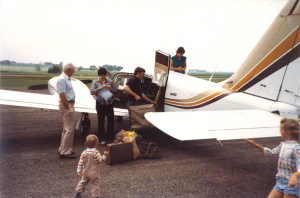Seneca II
In March of 1980, I purchased my first aircraft, a 1978 Seneca II. Turbo charged and especially suited for Colorado Mountain flying. Its rate of climb was exceeded by the record-climbing interest rates under Jimmy Carter. With prime at 21%, aircraft sales nearly grounded to a halt.
With our 14-year old son, Paul, taking lessons in the Seneca, it was decided we would keep the aircraft until he got his instrument and commercial. Paul soloed on his 16th birthday, got his private at 17, followed by his instrument and commercial. I justified his training costs by keeping him as an (indentured servant) pilot for several years. His lack of a single engine ticket seemed strange, but there were some special and unique memories created learning in a twin. While enrolled in school at BYU Idaho, he would fly home to Centennial Airport (APA) on Fridays and return to school in Rexburg early Monday mornings. Skimming the tops of the Tetons, with their majestic jagged peaks, just above the swirling, glistening snow, or summer flights in the Midwest, skirting or outrunning thunderstorms, created memories to insure that the hook was set for a lifelong passion for aviation.

My first aircraft, a 1978 Seneca II. Turbo charged and especially suited for Colorado Mountain flying
Lessons learned were sometimes more important than fun, like the time Paul was taking mountain flying training. He quickly pushed the throttles forward at the last moment at Lake County Airport (LXV), avoiding a gear-up landing, or the night over the Rockies, going from Monterey to Mazatlan and running into the 20-year storm. To say it snowed in Mexico is one indication. He experienced the worst turbulence imaginable that a light twin could handle, while busy shining his flashlight on the wings trying to measure ice build-up as the little twin bounced nearly out of control. Relating how he didn’t want to cause his passengers too much concern, he kept his prayers silent, knowing the plane was in bigger hands. On a July 4th weekend, he took family friends to St Louis to visit the famous caves that have been lighted and flooded for scuba diving. The passengers didn’t mention the extra equipment they would be bringing back or the time they needed to wait before flying after a dive. They ended up leaving St. Louis in the heat of the day, having to drain some fuel; the long runway was helpful. The flight was going fine until a significant vibration and some noise came from the right engine. Paul feathered the prop, shut the engine down and made an emergency call to Kansas City radio. They offered two suggestions: Junction City KS, straight ahead six miles, 2800 foot runway, or an Air Force base 30+ miles north with a 10,000 ft. runway. Paul chose Junction City.
Now the pressure was on to find the chart, the airport, and the runway direction while descending at the best rate. He had to manage the balance between taking care of the good engine, preparing for the chance it too could fail, and lining up for the runway and landing on the mark of the runway, because there would be no go-around. On the ground, Paul called home and said, “Dad, I’ve got good news and some bad news.” As usual, I wanted the bad news first. He said, “There are eleven new holes in the crank case of the right engine. The good news is that we landed safely in Junction City, KS.” At 17 years old, Paul’s flying got a little more serious; he grips the yoke just a little tighter as he considers options minute by minute.











